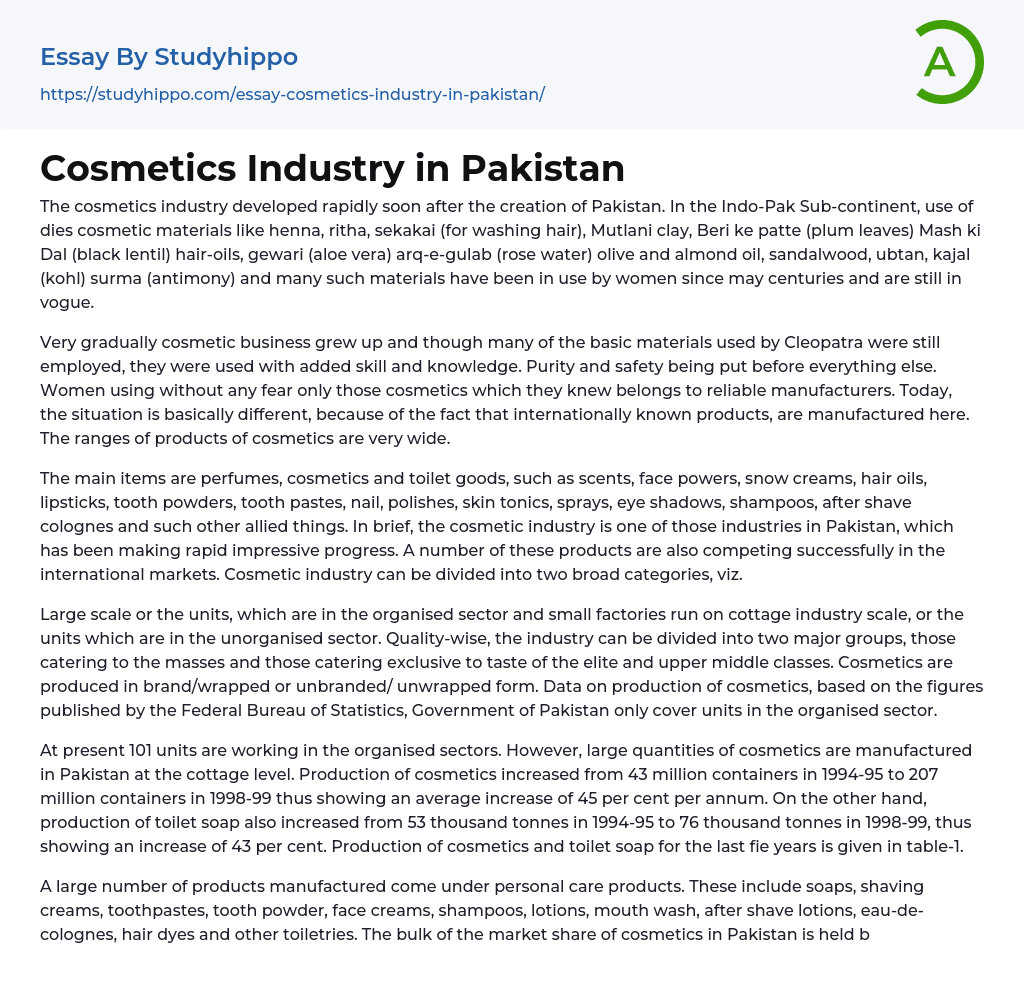The cosmetics industry developed rapidly soon after the creation of Pakistan. In the Indo-Pak Sub-continent, use of dies cosmetic materials like henna, ritha, sekakai (for washing hair), Mutlani clay, Beri ke patte (plum leaves) Mash ki Dal (black lentil) hair-oils, gewari (aloe vera) arq-e-gulab (rose water) olive and almond oil, sandalwood, ubtan, kajal (kohl) surma (antimony) and many such materials have been in use by women since may centuries and are still in vogue.
Very gradually cosmetic business grew up and though many of the basic materials used by Cleopatra were still employed, they were used with added skill and knowledge. Purity and safety being put before everything else. Women using without any fear only those cosmetics which they knew belongs to reliable manufacturers. Today, the situation is basically different, because of the fact that intern
...ationally known products, are manufactured here. The ranges of products of cosmetics are very wide.
The main items are perfumes, cosmetics and toilet goods, such as scents, face powers, snow creams, hair oils, lipsticks, tooth powders, tooth pastes, nail, polishes, skin tonics, sprays, eye shadows, shampoos, after shave colognes and such other allied things. In brief, the cosmetic industry is one of those industries in Pakistan, which has been making rapid impressive progress. A number of these products are also competing successfully in the international markets. Cosmetic industry can be divided into two broad categories, viz.
Large scale or the units, which are in the organised sector and small factories run on cottage industry scale, or the units which are in the unorganised sector. Quality-wise, the industry can be divided into two major groups, thos
catering to the masses and those catering exclusive to taste of the elite and upper middle classes. Cosmetics are produced in brand/wrapped or unbranded/ unwrapped form. Data on production of cosmetics, based on the figures published by the Federal Bureau of Statistics, Government of Pakistan only cover units in the organised sector.
At present 101 units are working in the organised sectors. However, large quantities of cosmetics are manufactured in Pakistan at the cottage level. Production of cosmetics increased from 43 million containers in 1994-95 to 207 million containers in 1998-99 thus showing an average increase of 45 per cent per annum. On the other hand, production of toilet soap also increased from 53 thousand tonnes in 1994-95 to 76 thousand tonnes in 1998-99, thus showing an increase of 43 per cent. Production of cosmetics and toilet soap for the last fie years is given in table-1.
A large number of products manufactured come under personal care products. These include soaps, shaving creams, toothpastes, tooth powder, face creams, shampoos, lotions, mouth wash, after shave lotions, eau-de-colognes, hair dyes and other toiletries. The bulk of the market share of cosmetics in Pakistan is held by three big companies, Kohinoor Chemicals, International Laboratories (Ponds) and Revlon. They control about 60 to 70 per cent share of the total market. Having large production facility and marketing set-up, they are able to dictate their terms.
Their products under brand name such as Swiss Miss, Medora of London, Tibet cream, Revlon, Ponds and Forhans have been established in people's minds. Important centers producing cosmetics in addition to Karachi are Hyderabad, Lahore and Rawalpindi. Most of the units
in the organised sector having modern technology and foreign capital, accounting for 67 per cent of the total capacity are concentrated in Karachi. They produce with a few exception, foreign brands of cosmetics and goods needing sophisticated manufacturing techniques and quality control methods.
Many pharmaceutical firms have also entered this field, and are manufacturing quality cosmetics. This industry with indigenous capital, employing simple manufacturing technology, mostly based on indigenous raw materials is spread all over the country at cottage level. In the past, except in a few cases, no modern marketing techniques or approaches were adopted, but since the eighties, the marketing activities have become more organised. Marketing of cosmetics is carried out under brand names. Some of the popular brands are Tibet, Ponds, Colibri, Medora, Kala Kola, Max Factor, Swiss Miss, Dylecia, Lux, Rexona, Forhans, Macleans, Binaca etc.
Preparations for skin and hair are full of choice ingredients and many are blended with fragrant perfumes. Preparations for skin in many shades are suitable for different complexions. They include a wide range of products, such as moisturizer, cleanser, hand and body lotions, foundation, etc. Selected ingredients go into making of spearmint and peppermint flavored dental creams and pastes. Hair creams and brilliantine are also the two fine quality cremes which are in wide use. Pakistan cosmetics have been categorised into creams, lotions for the care of the skin and hair.
- Automotive essays
- Real Estate essays
- Construction essays
- E Commerce essays
- Commerce essays
- Polymers essays
- Automotive Industry essays
- Paper Industry essays
- Textile Industry essays
- Pharmaceutical industry essays
- Pharmacy essays
- Grocery stores essays
- Classical Mechanics essays
- Rail Transport essays
- Tata Motors essays
- Vehicle Brands essays
- trucks essays
- Auto Racing essays
- Harley-Davidson essays
- Suzuki essays
- Lexus essays
- Mercedes-Benz essays
- Buying Homes essays
- Futures Contract essays
- Mortgage Loan essays
- Renting essays
- Transaction Cost essays
- Building essays
- Optical Fiber essays
- Freezing essays
- Polymer essays
- Weaving essays
- Cosmetics essays
- Makeup essays
- Skin care essays
- American Dream essays
- Barriers To Entry essays
- Capitalism essays
- Central Bank essays
- Compensation essays
- Consumerism essays
- Economic Development essays
- Economic Growth essays
- Economic Inequality essays
- Economic System essays
- Economy essays
- Employment essays
- Export essays
- Finance essays
- Free Trade essays




